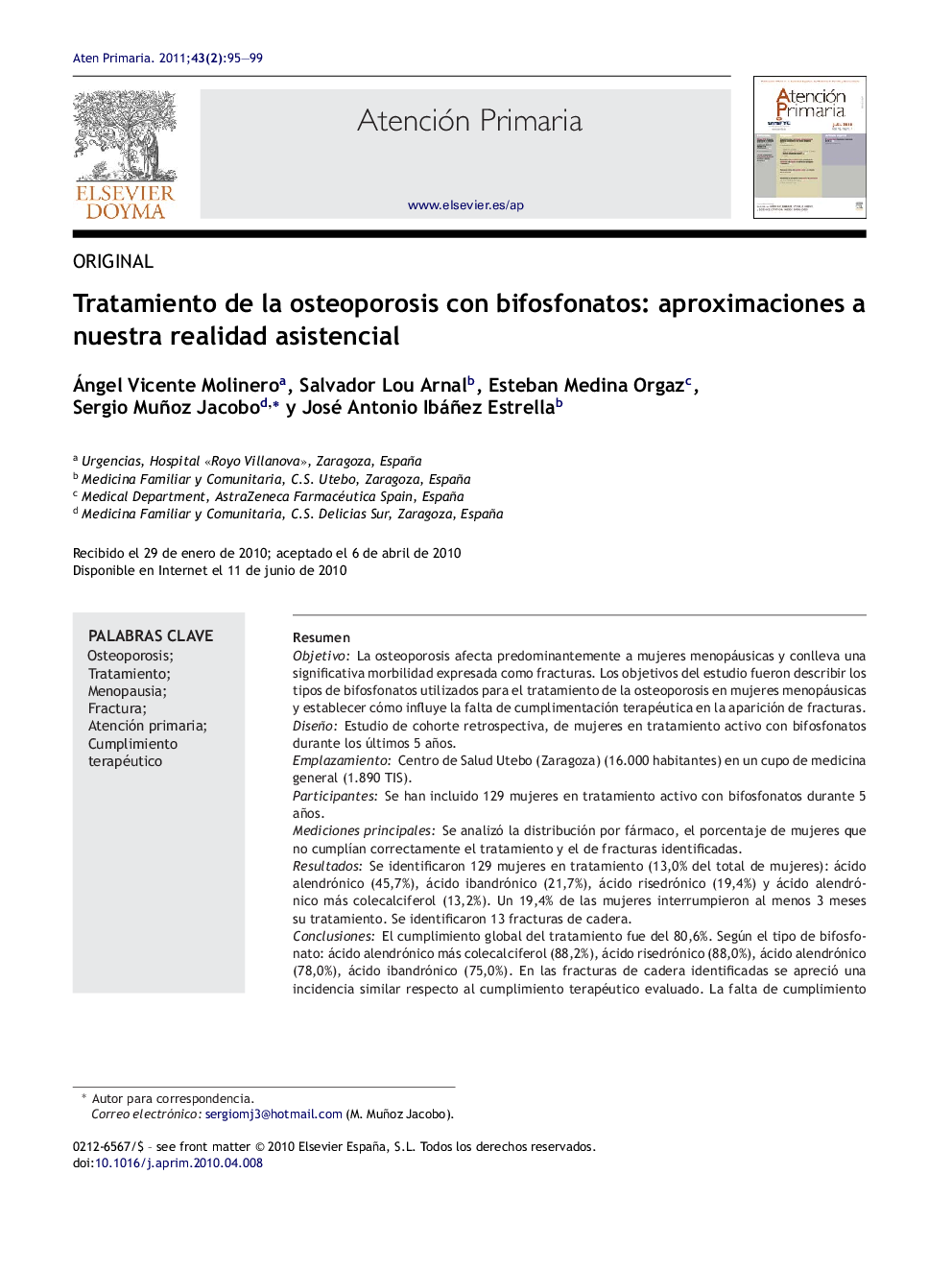| کد مقاله | کد نشریه | سال انتشار | مقاله انگلیسی | نسخه تمام متن |
|---|---|---|---|---|
| 3457332 | 1230901 | 2011 | 5 صفحه PDF | دانلود رایگان |

ResumenObjetivoLa osteoporosis afecta predominantemente a mujeres menopáusicas y conlleva una significativa morbilidad expresada como fracturas. Los objetivos del estudio fueron describir los tipos de bifosfonatos utilizados para el tratamiento de la osteoporosis en mujeres menopáusicas y establecer cómo influye la falta de cumplimentación terapéutica en la aparición de fracturas.DiseñoEstudio de cohorte retrospectiva, de mujeres en tratamiento activo con bifosfonatos durante los últimos 5 años.EmplazamientoCentro de Salud Utebo (Zaragoza) (16.000 habitantes) en un cupo de medicina general (1.890 TIS).ParticipantesSe han incluido 129 mujeres en tratamiento activo con bifosfonatos durante 5 años.Mediciones principalesSe analizó la distribución por fármaco, el porcentaje de mujeres que no cumplían correctamente el tratamiento y el de fracturas identificadas.ResultadosSe identificaron 129 mujeres en tratamiento (13,0% del total de mujeres): ácido alendrónico (45,7%), ácido ibandrónico (21,7%), ácido risedrónico (19,4%) y ácido alendrónico más colecalciferol (13,2%). Un 19,4% de las mujeres interrumpieron al menos 3 meses su tratamiento. Se identificaron 13 fracturas de cadera.ConclusionesEl cumplimiento global del tratamiento fue del 80,6%. Según el tipo de bifosfonato: ácido alendrónico más colecalciferol (88,2%), ácido risedrónico (88,0%), ácido alendrónico (78,0%), ácido ibandrónico (75,0%). En las fracturas de cadera identificadas se apreció una incidencia similar respecto al cumplimiento terapéutico evaluado. La falta de cumplimiento terapéutico es frecuente en mujeres menopáusicas, con lo que es conveniente promover medidas que permitan incrementar la efectividad así como concienciar a las pacientes de la importancia de un tratamiento continuado.
ObjectiveOsteoporosis predominantly affects menopausal women and has a significant morbidity expressed as fractures. The study aimed to describe the types of bisphosphonates used to treat osteoporosis in post-menopausal women and to establish how treatment non-compliance affects the fracture rate.DesignRetrospective cohort study of women on active treatment with bisphosphonates for the past five years.LocationUtebo Health Centre (Zaragoza) (16,000 inhabitants) with a general medical quota of 1,890 patients).ParticipantsA total of 129 women who were on active treatment with bisphosphonates for five years were included.Main measuresThe distribution by drug was analysed, as well as the percentage of women who did not comply with the treatment correctly and any identified fractures.ResultsA total of 129 women on treatment were identified (13.0% of all women patients): alendronic acid (45.7%), ibandronic acid (21.7%), risedronic acid (19.4%) and alendronic acid plus cholecalciferol (13,2%). 19.4% of women stopped their treatment after at least 3 months. Thirteen hip fractures were identified.ConclusionsThe overall treatment compliance was 80.6%, Depending on the type of bisphosphonate: alendronic acid plus cholecalciferol (88.2%), risedronic acid (88.0%), alendronic acid (78.0%), ibandronic acid (75.0%). The incidence of hip fractures was similar incidence to that observed with respect to non-compliance to treatent. Lack of therapeutic compliance is common in menopausal women, and measures should be promoted to increase effectiveness as well as to make patients aware of the importance of continuing treatment.
Journal: Atención Primaria - Volume 43, Issue 2, February 2011, Pages 95–99